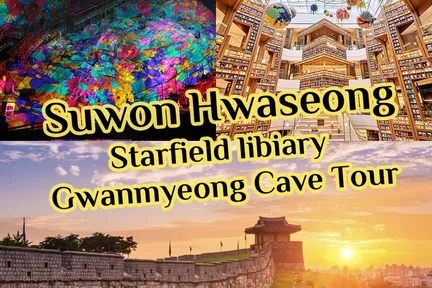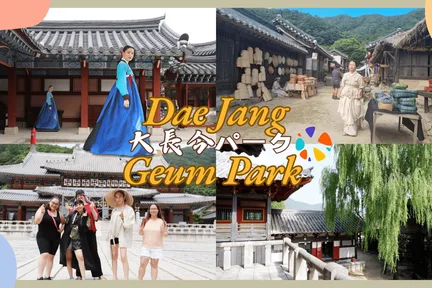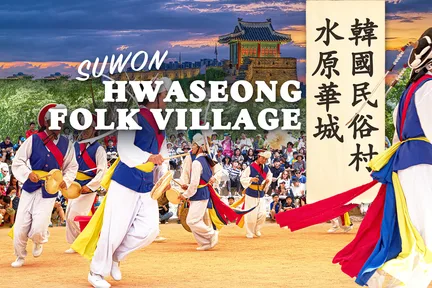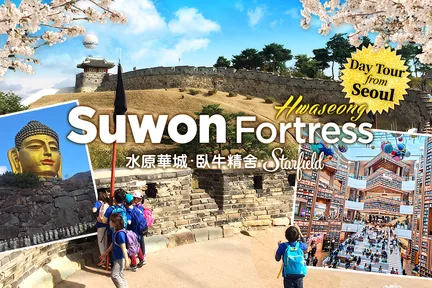Suwon Hwaseong Fortress

The best of Suwon Hwaseong Fortress
Bucket-list experiences
Make it a getaway
More to explore
Why people love Suwon Hwaseong Fortress
Nearby places to go
FAQs about Suwon Hwaseong Fortress
When is the best time to visit Suwon Hwaseong Fortress?
How can I get to Suwon Hwaseong Fortress from Seoul?
What local cuisine should I try when visiting Suwon Hwaseong Fortress?
What should I be aware of regarding conservation efforts at Suwon Hwaseong Fortress?
What kind of visitor information is available for Suwon Hwaseong Fortress?
Are there any nearby attractions to visit along with Suwon Hwaseong Fortress?
What to know before visiting Suwon Hwaseong Fortress
Remarkable Landmarks and Must-Visit Sights
Paldalmun Gate
Step through history at Paldalmun Gate, the southern sentinel of Suwon Hwaseong Fortress. This majestic two-storey wooden structure, perched on a sturdy stone base, is flanked by gated platforms and shielded by half-moon ravelins. As a key entry point to the fortress, Paldalmun Gate is a stunning example of traditional Korean architecture that will transport you back to the Joseon Dynasty. Don't miss the chance to marvel at its intricate design and historical significance!
Janganmun Gate
Discover the grandeur of Janganmun Gate, the northern counterpart to Paldalmun Gate and the largest gate in Korea. This impressive two-storey structure, with its semi-circular protective wall, served as the main entrance to Suwon Hwaseong Fortress. A visit to Janganmun Gate offers a fascinating glimpse into the architectural prowess of the Joseon Dynasty and the strategic importance of this historic landmark. It's a must-see for anyone interested in Korea's rich cultural heritage.
Haenggung Palace
Immerse yourself in royal history at Haenggung Palace, nestled within the walls of Suwon Hwaseong Fortress. This palace complex, comprising 22 buildings, served as a royal residence for King Jeongjo during his visits to Suwon. Wander through the beautifully preserved halls and courtyards to get a sense of the opulent lifestyle of the Joseon dynasty. Haenggung Palace is a captivating destination that offers a unique window into Korea's regal past.
Cultural and Historical Significance
Hwaseong Fortress is a testament to the brilliance of 18th-century military architecture, blending the finest scientific ideas from both Europe and East Asia. It played a pivotal role in shaping Korean architecture, urban planning, and landscaping.
Architectural Marvel
Designed by the esteemed scholar Jeong Yakyong, Hwaseong Fortress is a masterpiece that merges residential and defensive features, reflecting the cutting-edge scientific knowledge of its era.
Unique Design
Hwaseong Fortress stands out from other fortresses in China and Japan by integrating military, political, and commercial functions. This innovative site layout and multifunctional design make it a unique landmark.
Historical Significance
Constructed between 1794 and 1796 by King Jeongjo to honor his father, Prince Sado, Hwaseong Fortress was part of the king's grand vision to relocate the capital from Seoul to Suwon, aiming to create a thriving and strategically important city.
Architectural Marvels
The fortress, designed by the renowned architect Jeong Yakyong, incorporates contemporary science with traditional Korean and Chinese architectural elements. The use of brick, efficient pulleys, and cranes was groundbreaking for its time.
Restoration Efforts
Hwaseong Fortress has been meticulously restored based on the Hwaseong Seongyeok Uigwe, a detailed blueprint from 200 years ago. This careful restoration has preserved its historical integrity, earning it a spot on the UNESCO World Heritage list.
Local Cuisine
While exploring Hwaseong Fortress, be sure to indulge in local culinary delights such as Suwon galbi (grilled beef ribs) and traditional Korean street food available in nearby markets.
Historical Significance
During the Joseon dynasty, Suwon Hwaseong Fortress served as a key regional government center. Built to protect the city, it symbolizes King Jeongjo’s dedication to his father and his vision for a new, economically independent city.
Daily Performances
Visitors can enjoy a variety of daily performances, from traditional music and dance to martial arts demonstrations. These lively shows offer an engaging way to experience Korean culture.
Explore more on Klook
Top attractions in Gyeonggi-do
- 1 Everland
- 2 The Garden of Morning Calm
- 3 Jisan Forest Resort
- 4 Korean Folk Village
- 5 Hwadam Botanical Garden
- 6 Petite France
- 7 Gamaksan Suspension Bridge
- 8 Hwaseong Palace
- 9 Gapyeong Sheep Farm
- 10 Woongjin Play City
- 11 Edelweiss Swiss Theme Park
- 12 Bears Town
- 13 Hyundai Premium Outlet
- 14 Banghwasuryujeong Pavilion
- 15 Shinsegae Siheung Premium Outlets
- 16 Paju Heyri Art Village
- 17 Kalbongsan Natural Recreation Forest
- 18 Tando Port
- 19 Wawoojeongsa Temple
Top destinations in South Korea
- 1 Seoul
- 2 Busan
- 3 Incheon
- 4 Gyeonggi-do
- 5 Gangwon-do
- 6 Jeju



